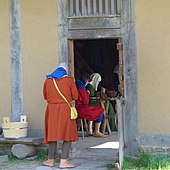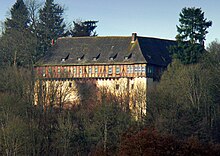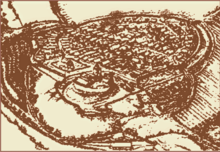Nienover
|
Nienover
Patches Bodenfelde
|
||
|---|---|---|
| Coordinates: 51 ° 40 ′ 50 ″ N , 9 ° 31 ′ 18 ″ E | ||
| Height : | 175–210 m above sea level NN | |
| Residents : | 353 (Aug 1, 2009) | |
| Incorporation : | March 1, 1974 | |
| Postal code : | 37194 | |
| Area code : | 05572 | |
|
Location of Nienover in Lower Saxony |
||
Nienover is a town in the Bodenfelde area in the Northeim district in southern Lower Saxony and consists of the Nienover, Amelith and Polier locations . On March 1, 1974, the former municipality of Nienover was incorporated into the patches Bodenfelde. In the 12th and 13th centuries, there was a town in the area below Nienover Castle , which after its destruction became the Nienover urban wasteland .
geography
The location of Nienover, consisting of houses, a domain, a water mill and the medieval center, has 42 inhabitants and is located in the southern part of the Solling around five kilometers (as the crow flies ) north-northwest of the core town of Bodenfelde , about three kilometers west of the B 497 on the L551 near the B 241 . It lies at about 175 to 210 m above sea level. NN in the valley of the Reiherbach , which arises from two source streams with the same name. Below the castle in the forest is the Carolin pond , which was created in 1971 and is named after Caroline von Brandenburg-Ansbach and fed by the Reiherbach. Immediately adjacent was a pond as a historical precursor, the dam of which had been pierced. Nienover is surrounded by wooded heights, the highest point of which is the Alte Schmacht mountain in the north ( 447.5 m above sea level).
history
Castle and chateau
Nienover Castle, built on a mountain spur, was first mentioned in 1144. Later the castle probably came first to Hermann II von Winzenburg and then to the Counts of Dassel , who moved their headquarters there around 1200. The castle came to Albrecht II in 1303. From here the dukes of Braunschweig went on hunting trips into the Solling. Duke Heinrich Julius von Braunschweig-Wolfenbüttel also used the castle regularly as a hunting residence. The castle was destroyed in 1626 during the Thirty Years War .
Between 1640 and 1656, today's castle was built from the remains of the castle, which Albrecht Anton Meldau built with a half-timbered upper floor and a sandstone roof . Until 1962 the castle was the official seat of a forester . From 1964 it was privately owned. In 1979 the state of Lower Saxony bought it under Prime Minister Ernst Albrecht for 1.8 million DM in order to use it as a guest house for the state government of Lower Saxony . The Lower Saxony state government later had the castle structurally renovated for almost 5 million DM. From 1984 to 2005 it housed a branch of the forestry faculty of the Georg-August-Universität Göttingen . In November 2005, the state government of Lower Saxony, led by Hartmut Möllring, sold the castle into private hands. It was used as a stud farm and is now privately owned again. The facility is mainly used for horse breeding. The castle is surrounded by a modern wall and is not open to the public.
Urban desolation

At the castle Nienover who founded counts of Dassel in 1180 when it was a city because of their size and later records a settlement. The settlement was laid out as a three-street system that led to the castle. On the north side the city was secured with moats and walls.
At one point in time between 1269 and 1274, Nienover was attacked. The wooden construction turned out to be disadvantageous, so that the entire place burned down. Only the castle remained usable in the following centuries. At the same time, the general economic conditions had deteriorated significantly, as the protective counts withdrew from the southern area through the sale of Schartenberg Castle . Therefore the houses were not rebuilt. On February 15, 1303, Count Simon von Dassel sold the castle and county of Nienover with the associated rights and possessions to Duke Albrecht the Feisten as sovereign of the Principality of Göttingen . With that the place came into the possession of the Guelphs.
The destroyed city has been used as arable and pasture land without building since it fell into a desert . Their physical existence was forgotten. The city wall , cellar, remains of the streets of the three-street system and other evidence of medieval settlement have been preserved in the ground . The complex is a rare example of urban desertification.
The desert was rediscovered by the archaeological research under the direction of Hans-Georg Stephan from 1996. Until 2004, archeology carried out annual excavation campaigns. After the sale of Nienover Castle in 2005, the new owner prohibited any further excavations on the site that belonged to his property. At the mediation of the Northeim district, a small area on the northern edge of the site was made available for a house reconstruction. In 2007, an urban half-timbered house from around 1230 was built on a scientific basis over an excavated cellar of a house near the street .
Landwehr

After the ramparts had proven to be unsuitable fortifications, a landwehr was built about 200 meters north of the castle . The exact time is unknown. Johannes Krabbe sketched their location in 1603 in his map of the Solling. A document is available for its elements, but it is interpreted as a phrase, so that it is assumed that the system was constructed in the usual way of that time. A bump of approx. 200 × 8 meters, which runs parallel to the B 241 as far as a damp depression, is interpreted as a remnant of the system. In the vicinity of Nienover there are remains of dams. In the first modern research, they were misinterpreted as part of the Landwehr, in that it was assumed that they would have been flooded the military road for defense with the water dammed up as a result.
Vorwerk and stud
The stately, formerly water-powered mill, which can be visited, is located below the castle as the remains of an outwork ; as well as the former official jug and a tithe barn . On the opposite slope, on the other side of the L551, is the Wildenhaus , an 18th century building that is reminiscent of the ducal stud that was in Nienover from the 16th to the 18th centuries. The beginnings of horse breeding in Solling go back to Erich and Elisabeth von Calenberg-Göttingen. The main building of the stud farm at that time stood where the Wildenhaus, built in the 18th century, now stands on the slope east of the castle. In 1760 the stud was relocated to Neuhaus im Solling . The establishment of the new stud in 2005 ties in with the tradition of local horse keeping. Trakehners are bred at the stud . The use of the area as pasture serves to maintain the historical cultural landscape.
Office
At times there was also the Nienover office . The places Bodenfelde, Wahmbeck , Schönhagen and Kammerborn belonged to the office located in the Principality of Calenberg . In the vicinity were the Fürstenberg office in the northwest, the Uslar office in the east, the Sababurg office in the southeast, the Karlshafen office in the southwest and the Lauenförde office in the west. The latter was finally merged with the Nienover Office to form the Nienover-Lauenförde Office, which was merged with the Uslar Office, forerunner of the Uslar district , in 1852 . Under the Westphalian occupation it belonged as a canton to the Göttingen district , then to the Landdrostei Hildesheim .
politics
coat of arms
The local coat of arms comes from the time when Nienover was an independent municipality and, like today, consisted of three localities Nienover, Amelith and Polier , this is symbolized by three spheres . The upper half of the coat of arms is reminiscent of the Counts of Dassel , who took care of the first expansion of the place in the Middle Ages.
Local council
The local council in Nienover consists of five councilors:
Culture
societies
The volunteer fire brigade is one of the well-known associations . It was founded in 1934. From 1939 there was a compulsory fire brigade. In 1951 it was re-established as a volunteer fire brigade. In 1979 the old school was converted into a fire station , which was replaced by a new one in Amelith in 1996. The fire brigade is equipped with a TSF-W portable pump vehicle . In 2012 a fire service support association was founded.
Regular events

In the summer months, Living History events take place in the Nienover urban desert area . Re- enactments of medieval life scenes and musical performances based on historical fragments are presented. Expert supervision and advice in terms of experimental archeology are provided by Petra Lönne for the Northeim district. The organizers provide the authentic location and offer the opportunity for realistic presentations.
The Hutewald project in the Solling-Vogler Nature Park is a permanent facility on the west side of Nienover .
Personalities
Worked here
- Ludolf II of Dassel
- Ludolf IV of Dassel
- Ludolf V. von Dassel
- Friedrich Wilhelm Compe
- August Seidensticker
Born here
literature
- Hannes Blieschies: In the Solling forests. Local history forays . Mitzkat, Holzminden 2007. pp. 235–247 (2 historical views)
- Petra Widmer: Gardens in the Weserbergland. A journey to parks and gardens along the Weser . Mitzkat, Holzminden 2004. p. 85
Web links
Individual evidence
- ↑ a b Flecken Bodenfelde: Numbers, data, facts . Retrieved March 23, 2011.
- ↑ Main statutes of the area Bodenfelde. Retrieved January 22, 2019 .
- ^ Federal Statistical Office (ed.): Historical municipality directory for the Federal Republic of Germany. Name, border and key number changes in municipalities, counties and administrative districts from May 27, 1970 to December 31, 1982 . W. Kohlhammer GmbH, Stuttgart and Mainz 1983, ISBN 3-17-003263-1 , p. 214 .
- ^ Georg Max: History of the Principality of Grubenhagen, First Part, 1862, p. 15
- ↑ Nathalie Kruppa: Dassel. C .: Nienover , in Jörg Wettläufer (Ed.): Courtyards and residences in the late medieval empire. A dynastic topographical handbook. Grafen und Herren (= Residency Research , Volume 15. IV, Part 1), 1st edition, Ostfildern: Thorbecke, 2012, ISBN 978-3-7995-4525-9 , pp. 301–304; Digitized via the website of the Göttingen Academy of Sciences
- ↑ Lower Saxony State Parliament - 15th electoral term, printed matter 15/1392 (pdf)
- ↑ Lower Saxony State Parliament - 11th electoral period, printed matter 11/3892 (pdf)
- ↑ Hans-Georg Stephan: Stadt Nienover - Untergang im Feuer, in: Archäologie in Niedersachsen 6, 2003, p. 51ff
- ↑ Walter Junge: Chronicle of the spot Bodenfelde . Bodenfelde 1983, p. 41
- ↑ Hans-Georg Stephan: "Nienover - a submerged medieval city in Solling", in: Archäologie in Niedersachsen 1 (1998), p. 97ff
- ^ Submerged city of Nienover on n-tv.de from March 31, 2009
- ↑ Thomas Küntzel: Between the state border and external fortifications: Municipal Landwehr of the Middle Ages in southern Lower Saxony. In: Göttinger Jahrbuch. 2004, p. 31ff
- ↑ Balzer Rock: The Landwehr facilities in the southwest of Solling, in: Northeimer Heimatblätter, 1967, pp. 3-15
- ^ Karl Löffler: Encyclopedia for Horse Friends, Horse Owners and Horse Breeders, Volume 1, Edition 2, 1863, p. 283
- ↑ Schlossgestüt Nienover - The Races ( Memento of the original from May 27, 2013 in the Internet Archive ) Info: The archive link was automatically inserted and not yet checked. Please check the original and archive link according to the instructions and then remove this notice.
- ^ Anton Friedrich Büsching: Erdbeschreibung, Neunter Theil, 1792, p. 297
- ↑ Flecken Bodenfelde: localities . Retrieved March 23, 2011.
- ↑ http://wahlen.kds.de/2011kw/Daten/155002_000017/index.html
- ↑ Chronicle ( Memento of February 14, 2015 in the Internet Archive )
- ↑ Annual General Meeting 2013 ( Memento of the original from June 12, 2013 in the Internet Archive ) Info: The archive link was inserted automatically and has not yet been checked. Please check the original and archive link according to the instructions and then remove this notice.




